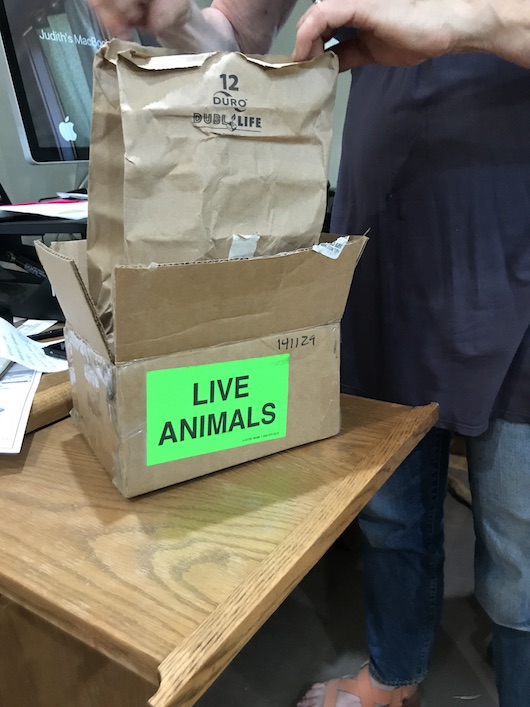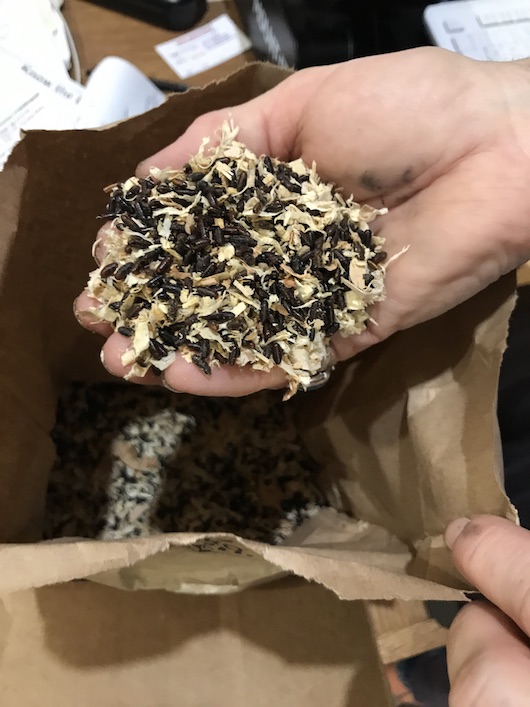
Last week I picked up a phone call from the post office letting us know that we had a special package to pick up. This was a little more exciting than the average box of seeds or office supplies – it was a shipment of baby chickens! Sending chicks through the mail is nothing new, it’s been standard for over 100 years, but I always find it a little mind-boggling that you can get chicks in the mail just like you do a pair of shoes.
Chicks aren’t the only living creatures we get through the mail. We also order a few types of insect to assist our on-farm biocontrol team. Biocontrol means using natural enemies to manage pests. We deal with a lot of insect pests on the farm. These pests harm the plants by eating leaves and fruits, transmit diseases to our crops which kill or greatly reduce production of those plants, and/or cause severe cosmetic damage that makes produce unsellable. There are a number of ways to deal with them, but one way is to harness their natural enemies, be they predators, parasitoids, nematodes, orpathogens.
One example of a predator would be ladybugs, which are great at eating aphids. Some of you may have noticed a few stowaways in your boxes over the past few weeks, a sign that we’ve got a lot of bugs out there helping us out! We don’t order ladybugs through the mail, but this spring we have ordered lacewings because their larvae are active predators of soft-bodied insect pests like aphids, thrips, whiteflies, leafhoppers, spider mites, and mealybugs. In the summer we’ll order and release trichogramma, tiny parasitic wasps that lay their eggs in and feed on eggs of moths and butterflies, particularly corn earworm, which as its name suggests, is preys on our sweet corn. We also get a blend of three parasitic wasps that prey on flies near our animals. We’ve tried other insect helpers in the past, but this is the current mix.

This box, labeled “live animals” contains fly pupae, each one of which carries a secret. Instead of hatching a fly, a tiny wasp will hatch out, ready to lay its egg in other fly pupae which it will seek out.

Buying insects for the farm is only one approach to biological control. Augmenting natural predators this way is fine, but our preferred method is to attract and support populations of existing or naturally occurring beneficial organisms by supplying them with appropriate habitat and alternative food sources. This way they’re already at the farm. Easier said than done though – it requires a bit of planning and intentionality to create a healthy habitat which will include hedgerows, cover crops, water sources, and insectary plants. Full Belly Farm was designed with these goals in mind. We’ve got four hedgerows (totaling about a half mile!), fields are laid out like a patchwork quilt to break up large blocks of crops, and we think about crop diversity within those fields. As a result, the predator insects that we want to deal with certain pests also have a home and source of food and shelter during other points in the year and at other points in their life cycle. For example, those lacewing larvae that love to snack on insects eventually turn into adult lacewings that live off of nectar and pollen, so we need to have adequate diversity and quantity of flowering plants in our hedgerows and fields to provide that kind of sustenance year-round.
But sometimes it makes sense to order in some reinforcements and when we do, it makes for a fun run to the post office when you get a box labeled “live animals” – though opening a bag of fly parasites is considerably less dramatic and much less cute, than a box of chicks!
— Elaine Sweidler
CSA Manager
